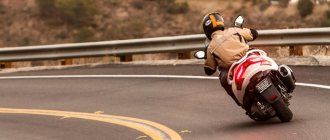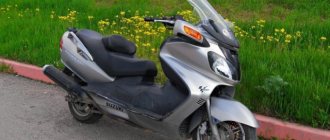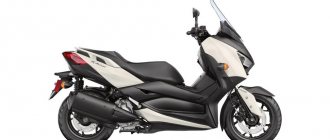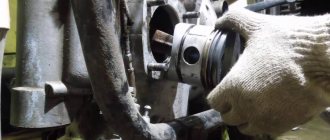Scooters: knowledge base
Motor: 582 cc liquid-cooled parallel twin can accelerate the scooter to 180 km/h. The engine resource is quite long - about 100 thousand km. The engine consumes 5.5-6.5 liters of gasoline per 100 km.
Clutch: the motor located in the depths of the frame is connected to the variator unit by a centrifugal clutch. It is similar to a similar unit in “fifty kopecks”: the same bell, the same pads, springs, rollers, only everything with the “maxi” prefix. In a working Honda Silver Wing 600, the clutch should engage at 2500 rpm, that is, at these revolutions the scooter should start moving.
Transmission: A belt is used as the final drive.
Suspensions: simple and reliable, the suspensions have remained unchanged since 2001. The conventional telescopic fork (120 mm travel) is non-adjustable; a 5-step spring preload adjustment is available for a pair of rear shock absorbers (115 mm travel).
Rider and passenger seat: wide and comfortable, divided into rider and passenger areas. The first one has an adjustable back support, the passenger part is wider and is located 150 mm higher than the driver's, which guarantees good visibility while driving.
Wheels and tires: 14-inch wheel at front, 13-inch at rear. Typically, the Honda Silver Wing 600 is equipped with Bridgestone or Dunlop tires. There is an alternative - Italian Pirelli. It must be remembered that the Silver Wing is a very heavy vehicle, and if the front wheel skids, it will be almost impossible to keep from falling. So don't skimp on tires.
Wind protection: The wind shield on the Honda Silver Wing 600 is large, but not adjustable. If you are very tall or broad-shouldered, order a larger one from the list of factory accessories. It is 70 mm higher than the standard wind protection. It is also worth paying attention to a set of side deflectors that remove the flow of incoming air from the knees.
Fuel tank: designed for 16 liters of gasoline and located in the central tunnel, right under your feet. This helps centralize the masses and makes the tank easier to access.
Luggage Space: Capable of holding 55 liters of luggage and easily accommodating two full-body helmets. Under the steering column there are two glove compartments for small items. The rear luggage platform of the Honda Silver Wing 600 is ready to accommodate a 45-liter top case.
Tidy: quite readable, without any claims to being sporty. Controversial in all respects, the round LCD display displays engine temperature, fuel reserve and other data.
Brakes: All Honda Silver Wing 600s come with Nissin 3-piston front and 2-piston rear combo brakes. When you press the right lever, the two pistons of the front caliper are activated. By pressing the left lever, one piston of the front and two pistons of the rear caliper are activated. Since 2004, ABS has been available on Silver Wings. On the rear disc there is another cable-actuated caliper - a parking brake. It is activated by a lever under the right glove compartment.
Honda Silver Wing
The flagship of the Honda scooter line, which appeared in 2000, became the largest, fastest and most expensive maxi-scooter. But, despite the price tag, the car has become extremely popular all over the world.
Story
In 2000, Honda presented to the public a completely new model of the Honda Silver Wing maxi-scooter with two versions of two-cylinder in-line engines with a volume of 400 and 600 cm3. “Silver” differed from its predecessors and competitors not only in its unprecedentedly high level of comfort, but also in the engine installed in the frame, with a variator on a separate “rocker” (like the Yamaha TMAX that debuted in the same year).
This design provided not only greater chassis rigidity, but also lower unsprung masses, having a positive effect on handling. In 2002, the relay-regulator “moved” from the back of the scooter under the fairing, and in 2003, a “MODE” button appeared on the steering wheel, allowing you to slightly change the injection mode, adding power to the engine, for example, when overtaking and on climbs. That same year, optional ABS was added to the standard combined braking system.
By 2004, the entire Silver line had undergone minor changes: the design of the glove compartment lids was redrawn, and with it the reliability of their opening mechanism increased, the headlight reflector housing began to be finished “in chrome” instead of painted black. The material used to cover the seat and the instrument lighting have changed: now it is illuminated with bright white light instead of dull amber. From the same year on all “Silvers” the wheels and fork cups began to be painted black.
This coloring lasted until 2007, then the wheels began to be painted “silver” again. In 2006, on the 600 cc versions, the ignition switch received an immobilizer, sidelight bulbs were added to the headlight, and the backlight of the LCD display on the tidy became blue. The cut of the seat upholstery has changed and gray leatherette inserts have been added.
By 2008, Honda prepared the next version of “Silver”, which can be distinguished by wheels, brake calipers and nameplates painted in golden color, as well as by a seat finished in a carbon fiber look.
Officially, Silvers were sold in Russia until 2009. The maxiscooter did not set sales records due to the inhumane price list, and the secondary market added fuel to the fire, offering “lightly worn tuxedos” at almost half the price.
In 2009, the design was radically refreshed: the plastic and optics were completely redesigned. The engine has changed slightly: a lambda probe (oxygen sensor) has appeared in the exhaust system, due to which fuel consumption has been slightly reduced. Otherwise, it’s the same “Silver” with a dimensionless “toilet”, comfortable and soft.
For what
For life. "Silver Wing" is perfect for moving both short and long distances. Excellent wind protection and seat capacity for two helmets contribute to long-distance performance, and a very responsive engine will allow you to start first at any traffic light.
By the way, in terms of dynamics, the 400 cc version is not much inferior to the 600 cc, but the presence of a passenger changes the picture significantly, so for shared trips it is better to choose a “six hundred”.
“Silver” is not conducive to active movements: considerable weight, a “cotton” scooter fork (with one traverse) and a “liquid” frame do their job. The brakes are the opposite: the combined system allows you to abruptly stop a heavy car from any speed, and coupled with ABS, you don’t even have to think about the grip properties of the asphalt under the wheels.
Where to look
The first, pre-restyling generation of “Silvers” can easily be found on Internet portals, in private advertisements or in salons selling second-hand goods. They were also sold here, so it is quite possible to find a device purchased and serviced from officials, with a service book and a clear history.
It won’t be difficult to bring your favorite copy to order from Japan or America, since there are plenty of companies providing such services. The second generation of Silvers is much less common, and they were not officially sold in Russia. It is for this reason that it is difficult to buy a used device from us; there are very few offers. The easiest way out is to bring it to order.
Choice
In general, “Silver” is reliable and simple, like a Kalashnikov assault rifle, but when choosing a used device, and especially one with mileage in Russia, you should pay attention to several points. Firstly, when driving with a passenger on a rough road, with a strong impact and “punching through” the rear suspension on the variator housing, the mounting location of the left shock absorber comes off. Cracks or welds will indicate that the “ear” will either come off soon or have already come off.
The second “sore” of the car can be called the fuel pressure valve, which “dies” from bad gasoline. When it fails, the engine starts to pull worse and stops idling. The parking brake has its own separate caliper.
Often the sensor for turning it on “glitches”, which is why the indicator on the device does not light up, and many “users” hit the road, surprised that the scooter “does not go”. The pads burn out quickly from driving with the handbrake, so the sensor should be kept clean and in case of “death”, replaced as quickly as possible.
As for the plastic, it covers the Silver from head to toe and has a lot of fasteners and latches. Fasteners break both from driving on broken roads and from crooked servicemen. It can be treated by soldering or replacement, and you can recognize the problem by looking at the gaps between the parts and how the part fits. This especially applies to the front fairing and the rear cladding. The only exceptions will be where the floor (driver's footrests) adjoins the lower part of the fairing: all Silvers have an uneven and rather large gap there.
It is also worth looking behind the front wheel and assessing the condition of the radiator. It is located low, and dirt flying from the front wheel partially remains between the plates, impairing cooling. If an inspection of the device does not reveal any problem areas, it is still worth taking it for a ride before purchasing. A slight wobbling of the steering wheel will indicate the “death” of the steering column bearings, and a transmission whistling when starting from a stop will indicate worn-out springs of the centrifugal clutch pads. The problem is trivial and, as they say, “does not affect the speed,” it’s just that the pads touch the clutch drum a little earlier, or even at idle, making a characteristic sound. Springs are inexpensive, and replacing them is not difficult for an experienced mechanic.
And one more thing: when choosing a device produced from 2003 to 2007, white, blue or silver, you should not pay attention to the fact that the plastic “pallet” of the floor covering is not painted in the same color. These are factory paint options.
Tuning
They don’t like it, and there’s not much to improve in it. With the exception of the transmission, you can replace the variator with a “Multivar” from Malossi, and the centrifugal clutch with a kit from the same manufacturer. This will help to slightly improve the acceleration dynamics and slightly increase the maximum speed.
As for travel, the picture is somewhat better here: a windshield (for example, GIVI) and a set of deflectors for the fairing and handlebars will improve the wind protection of the driver. Heated grips, for example, from Oxford or Saito, will add comfort. You can increase the carrying capacity by installing a central case, since there is a platform for attaching it on all Silvers.
There are no hard side cases for this maxi, so the problem can be solved either with textile side bags, or you will have to take up a grinder and welding, inventing fastenings yourself, or contact an office that manufactures such devices.
On the outside, the “six hundred” differed from the “four hundred” in the color of the fork stays, wheel rims, the rear passenger handle and the brackets for the passenger footrests: on the “four hundred” they were painted in dark gray metallic, on the “six hundred” they were painted silver. The frame numbers also differ: for “four hundred” they begin with the letters NF, for “six hundred” they begin with PF.
You can try to turn “Silver” into “Golda” with the help of light bulbs, diodes, foglights and music installation, fortunately there is enough space for everything. But this is a matter of taste.
Hi all! I am writing about my experience of owning a 2004 Honda Silver Wing 400 maxi-scooter. I described the purchase process, registration and first impressions in the previous post. At the moment, the odometer shows 44,000 km, that is, I have driven 14,000 km and continue to drive, despite the not the best weather in Moscow. I drive almost every day and have never regretted it, rain, night, cold, nothing stops me from getting behind the wheel, and the vehicle itself contributes to this.
I took the device as a practical means of transportation for every day and to fulfill an old dream - traveling on two wheels to the Crimea, so as not to spend half the price on preparing the motorcycle (wind deflector, mounts, panniers, the maxiscooter has all this in the base) and the choice was completely justified. In light rain you can do without a raincoat, the wind protection is good, your feet are always dry. For the second number, the situation is a little worse, the legs are on retractable footrests and all the wind and water hits them, as well as the hands and helmet, since the passenger sits slightly higher than the driver. Some people solve this by installing side deflectors and a Givi Airflow windshield, but I stayed with stock.
The most practical city vehicle, I would call it a two-wheeled car, the comfort and luggage capacity are pleasing. I bought an additional Chinese case for 51 liters. for 5000 rubles, nothing fell off, nothing became loose, although I loaded it heavily. I shop at Auchan for two for two weeks and everything fits. It’s convenient that you don’t have to carry around with a helmet; when you arrive, you put it in the trunk and go.
Driving around the city is a pleasure, CVT, no work with the clutch or gears, the device is quite narrow and fits in the same places as all other two-wheelers. 250 kg of weight on Dunlop Scootline tires hold the road perfectly, the rear skidded twice in a turn in a wet place, I just eased off the gas and leveled off, the combi brake on the left handle is again very convenient, if it’s not enough I apply the brakes with the front handle, it never blocked, and I stopped where I wanted. Some say the brakes are sluggish, for such a mass and two brake discs this may be true, but it’s always enough for me, again, everything is individual.
During the season I changed all consumables and fluids. At first I drove with synthetic car oil, the engine is similar to a car without a wet clutch, then I switched to Motul Scooter Expert because I found an affordable supplier, I didn’t notice any difference. At first the engine was burning oil - I decarbonized everything and everything was back to normal. The manual says to change the oil every 12,000 km, I changed it at the beginning of the season, then at 8,000 km. Oil filter 500 rubles. Nissin pads, 2500 rub. front and the same amount back. Luka antifreeze, no complaints, the temperature was always normal even in the hot Crimean climate. I changed the brake discs since the original ones were already noticeably worn out, I ordered the simplest ones from eBay, the front and rear ones cost 5,000 rubles. I didn’t notice any difference with the original, and after replacing the brakes and pads everything became even better.
I got the device with a variator and a Malossi belt, the dynamics in the city, given the two-boiler 38 horsepower engine and despite the weight of 250 km, are very decent, as for me, without failures, it reaches 5500 rpm and accelerates at the moment to 90 km/h, then the power and maximum work reaches a maximum speed of 150 km/h at the cutoff (tried it once), and the cruiser on the highway is 110-120 km/h at 6500-7000 rpm. I planned to install a stock valve and belt (5000+5000 rubles) to slow down the speed, since I’m not much of a racer, but then I got used to it and was afraid of losing dynamics, and I don’t go out on the track very often. With a passenger, the dynamics drop slightly, but this did not stop me from driving to the Crimea and back in two on a scooter loaded to capacity, I did not feel any inconvenience. Consumption due to the CVT does not change much depending on the city and highway and is 5-6 liters per hundred. With a tank of 15 liters, after the 200 km mark on the odometer, I look for a gas station; I don’t particularly rely on the fuel level sensor, since the first two bars are enough for a hundred kilometers, and the remaining 4 bars go away faster. The manual says to pour gasoline above 91, I fill it with 92, tried 95 - I didn’t feel any difference.
About the suspension. I expected much worse, since the wheels are small (14 front, 13 rear), but everything turned out to be not so bad, in the city there is nothing to complain about at all, speed bumps are driven over just like in a car, leisurely. The ground clearance is almost the highest among the Maxi cars, I paid attention to this when choosing. It probably hit the suspension only 3 times, and then on the rough roads of Crimea with two people on a loaded scooter. Some people say that the front suspension is rather weak and soft, fill in thicker oil 15-20w, install valve springs from VAZ, but I am completely satisfied with the oil according to the manual 10w, everyone has their own driving style. The rear suspension is adjustable, for me it is 4 out of 5 in terms of stiffness.
Now a little about the Crimean journey. I took a vacation for two weeks, we planned to leave on August 15, it was another day, 13 degrees and rain, but that didn’t stop my friend and I, we loaded our things, dressed warmly, put on our raincoats and off we went. Despite the conditions on the wet track, I was moving consistently at about 100 km/h, there was no need to be nervous, Silver walked like a cruiser along its fairway, and after the rains it reached the usual 110-120 km/h. We prudently bought Intex air cushions, attached them with double-sided tape, and the backside was the last thing that got tired during the trip, the main thing was to pump up the right amount of air. I won’t go into much detail, enough has been written about the road to Crimea at Bikepost and my journey in this regard went without any surprises, with the exception of the dead bearing in the front wheel already at the entrance to the planned housing in the city of Sudak. Driving in the dark along a serpentine road with a threateningly crunchy bearing, let me tell you, is not for the faint of heart. By the way, the light on the Silver is rather weak, you can only see the markings, and the shadows from the bumps on the road in front of your nose, the adjustment did not help. In the end, I successfully arrived, bought bearings in Simferopol and replaced them. On the way back to Voronezh I caught a nail in the rear wheel. He pulled it out and put on a tourniquet. 100 km from home I discovered a flat tire, drove another 20 km constantly pumping it up, and finally decided not to risk it and called a tow truck. Then I changed the tires to the same Dunlop ones, I’m completely satisfied. Nothing else broke during the entire season. The impressions from the first long-distance trip were mixed, I seemed to like it, but as a vacation it was not the best option, since out of a two-week vacation, 6 days were on the road (3 days there, 3 days back, 600 km a day) and 7 days resting in Sudak . A few photos: I’ll say something about the 600 cc version, initially the scooter was designed specifically for this engine, and the 400 cc version was made later. I knew very well about the advantages of a larger capacity vehicle: it has better dynamics and higher cruising and maximum speed, while it is expectedly more expensive and consumes more fuel. To be honest, on the highway I would gladly drive a 600, but in the city the difference is not so visible, and lower fuel consumption is a plus for a 400. My version competes with the 400 Skyway, and the 600 already competes with the 650 Burgman, both in terms of characteristics and cost, and the choice is not so obvious.
As for the maxiscooter class itself, my opinion is the following: yes, this is not a motorcycle. You won't get the same emotions as in sports from acceleration and speed. You won't get the same emotions as a cruiser, slowly driving around the city with the exhaust rumbling. There is nothing to say about off-road. This is just a workhorse, as practical and reliable as possible. I’m completely happy with this season and the fact that I rode it on Silver, but next season I’ll probably take a motorcycle. Now I’m slowly selling it, it’s in the advertisements, if I don’t make it before the snows, I’ll put it in storage.
Separately, I would like to say about the Northern Wing Silver Breeders Club, of which I had the honor of becoming a member, they are very kind, cheerful and sympathetic people who are ready to help or give advice at any time, it’s a pity that it’s not possible to go to meetings so often.
Thank you for your attention!










